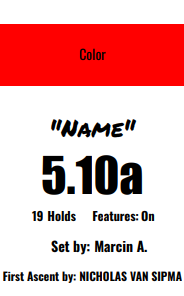Routes
Climbing’s guided detours
A rock climbing route is like a marked path on the rock, indicated by colorful strips of tape. These routes vary in difficulty, offering options for beginners to advanced climbers. To follow a route, climbers simply look out for the tape and use the holds that match its color.
Each rock climbing route is conveniently equipped with a tag that acts as a helpful guide. These tags disclose the difficulty level of the route and whether it is suitable for top rope or bouldering. The tags serve as informative signposts to ensure climbers can easily identify and choose routes that match their skill level and preferred climbing style. So, whether you're seeking a challenging ascent or a thrilling bouldering experience, the route tags have got you covered!
How do you read a tag?
White indicates a Route
Blue indicates a Boulder
Grade
Climb On offers an array of climbing options suitable for climbers of all skill levels, utilizing two grading scales: the Yosemite Decimal System (YDS) for routes and the Hueco scale for boulder problems. The YDS provides a numeric rating from 5.0 (easiest) to 5.15 (most challenging) to indicate the difficulty of a climbing route. On the other hand, the Hueco scale assigns ratings from V0 (beginner-friendly) to V16 (extremely demanding) to evaluate the difficulty of boulder problems. This means that at Climb On, beginners can start with routes rated 5.6 and boulder problems marked V0, gradually progressing to more challenging climbs as they gain experience and skill. The higher the number on either scale, the tougher the climb becomes, offering climbers exciting challenges to conquer at Climb On.
Features
A route may incorporate features such as cracks, aretes, and other variations in the climbing wall surface. These elements can pose distinct challenges that require climbers to employ specialized techniques like hand-jamming in cracks or utilizing smearing and stemming on aretes. It's important to note that while some climbs will allow the use of these features, others might not, requiring climbers to adapt their strategies and techniques accordingly. These unique features enhance the diversity of climbing routes and provide opportunities for climbers to expand their skillset and problem-solving abilities.
Tape
Tape is an essential tool used at Climb On to clearly mark the route from beginning to end. A consistent color of tape is used throughout to ensure visual continuity. The starting point of the climb is indicated by the route's tag, usually found on the first hold. In some cases, routes may have an alternative starting hold, which is illustrated by a taped "V" shape. Additionally, tape is used to indicate the end or finish of the climb, whether it involves reaching the top of the wall or a specific hold. This is also typically denoted by a taped "V" symbol, making it clear where the route concludes.
“Project”
A Project tag at Climb On designates a route that remains unclimbed, eagerly awaiting its first ascent. These routes have already been assigned a difficulty grade and are waiting for a bold climber to conquer them. Once a climber successfully completes the route without falling, they earn the honor of having their name added to the route tag. To claim this achievement, one simply needs to remove the yellow tag from the wall, present it to the front staff along with their name, and within a few days, a new tag proudly displaying their name will grace the route.
Yellow indicates a Project
It is essential to keep in mind that tape usage can vary between climbing gyms, with each facility having its own specific systems and conventions. To gain clarity and understanding, we advise checking with our knowledgeable gym staff or referring to any posted information regarding the specific meanings of tape colors at Climb On. As you continue to gain experience, you will become more accustomed to the conventions utilized within our gym, making it easier to navigate and fully enjoy your climbing sessions with us.




